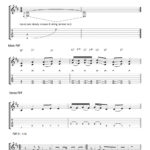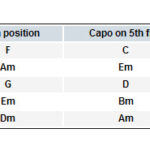The dreaded sound of a guitar neck snapping is a nightmare for any guitar player. It’s a common issue, especially with certain guitar designs, and understanding why it happens is the first step in prevention and proper repair. The Neck Of Guitar, particularly where the headstock angles back, is inherently a weak point. This isn’t necessarily a design flaw in the intentional sense, but rather a consequence of structural necessities and material properties.
Several factors contribute to this weakness in the neck of guitar. Firstly, the wood grain direction at the angled headstock runs short across the thinnest section of the neck of guitar. This area is already naturally slender to facilitate comfortable playing, but this reduced mass is further compromised by the direction of the wood grain. Adding to this structural challenge is the truss rod access channel. Many guitars have this channel routed through the neck of guitar in this critical area, removing even more wood and creating a significant stress concentration point. As you can see in the image above, illustrating a Les Paul neck of guitar, the truss rod cavity drastically reduces the remaining wood in this vulnerable spot.
To combat this inherent weakness in the neck of guitar, many luthiers and guitar manufacturers employ various techniques. These include constructing guitar necks from multiple plies of wood, creating a stronger ‘sandwich’ structure. Another approach is relocating or minimizing the truss rod access point to preserve more wood in the headstock area. Scarf joints, where the headstock is joined to the neck of guitar with a less severe angle or a stronger joint type, are also used. Perhaps the most common method is the volute. A volute is a carve or bulge strategically added to the back of the neck of guitar at the headstock transition. This reinforces the weak spot by effectively increasing the mass of wood and changing the grain direction in that critical zone.
However, not all guitar makers consistently utilize these strengthening features. Gibson, for instance, while introducing the volute on many models in the late 1960s, has since phased it out on many modern guitars. Consequently, while any guitar with an angled headstock carries a risk of breakage, Gibson guitars, particularly models like SGs and Les Pauls, are statistically more prone to headstock breaks. This unfortunate reality keeps guitar repair technicians consistently busy. Ironically, widespread implementation of neck strengthening techniques by manufacturers might lead to a decrease in guitar repair shop revenues globally!
What To Do If You Damage Your Guitar Neck
Discovering a crack or break in your neck of guitar can be distressing, but it’s crucial to remember that most breaks are repairable. Immediate action is key to minimizing further damage and ensuring a successful repair. Here’s a step-by-step guide:
-
If the headstock is still partially attached: If the headstock is broken but held in place by the headstock veneer or a partial connection, the first and most important step is to immediately relieve string tension. Gently and slowly loosen the tuning pegs to slacken the strings. Place the guitar carefully in its case and take it to a qualified guitar repair professional as soon as possible.
-
If the headstock is cracked: Even with a crack and not a complete break, the procedure is the same. Loosen the strings to reduce stress on the neck of guitar, case the instrument, and seek professional repair.
-
If the headstock is completely detached: If the headstock has completely separated from the neck of guitar, carefully wrap the detached piece in soft material like a bag or newspaper to protect the broken edges. Be particularly careful not to disturb or further damage any splintered wood.
-
Do not attempt to glue it yourself: Resist the urge to immediately try to glue the headstock back onto the neck of guitar. A proper repair requires careful assessment, cleaning of the break, and precise alignment. Attempting a DIY repair can complicate the process and potentially weaken the final repair.
-
Collect any loose splinters: Check for any wood splinters that may have detached from the break. If you find any, collect them and place them in a small bag. These fragments can be invaluable for achieving a clean and strong repair, like pieces of a jigsaw puzzle.
The Importance of Professional Guitar Neck Repair
The initial repair of a broken neck of guitar is paramount. A poorly executed repair significantly increases the risk of future breaks along the same fault line. String tension alone can be enough to cause a weak repair to fail. Furthermore, repairing a previously repaired break is considerably more complex, time-consuming, often requiring more invasive procedures, and consequently, more expensive.
The key takeaway is preventative: avoid breaking your neck of guitar in the first place. However, accidents happen. If your guitar neck does break, ensure it is repaired correctly the first time by a skilled technician.
Engage in a conversation with your chosen repair technician and discuss their repair plan. A reputable repairer will gladly explain their approach. Inquire about the type of glue they intend to use. For most neck of guitar repairs, hot hide glue or aliphatic resin are the preferred choices. If epoxy resin is the immediate suggestion, it’s wise to ask for clarification on why. While epoxy has its applications in guitar repair, its use is generally limited in headstock breaks. Epoxy is exceptionally strong when applied correctly, but its properties often make it less suitable for penetrating cracks and achieving the best bond in these types of repairs compared to traditional wood glues.


